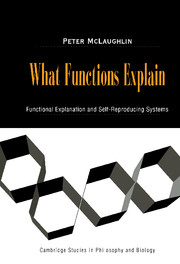3 - Intentions and the Functions of Artifacts
Published online by Cambridge University Press: 12 August 2009
Summary
ACTUAL AND VIRTUAL (RE)ASSEMBLY
Function attributions and functional explanations in science deal with nonintentional entities or with intentional entities under abstraction from their intentionality. A functionalist approach to social phenomena, for instance, does not deny that individuals have purposes, motives, and intentions, but it does not appeal to these to explain the individuals' activities. In fact, it may even appeal to functions to explain the existence and nature of particular purposes, motives, and intentions. A functional explanation in biology, say of the bee-hunting behavior of wasps, does not ascribe intentionality to organs and tissue or even to the organism as a whole, but it need not deny this intentionality in order to be a functional explanation. What is relevant is that a functional explanation is independent of any attribution of intentionality. Functional explanation in social science tends to be more easily misunderstood because many social institutions or cultural practices that might have an intelligible functional explanation may also be thought of as having an intentional explanation, and many social institutions were in fact intentionally founded or are now shaped and supported for particular purposes. Let us assume that public executions in a particular society have the function (and the actual effect) of representing power in naked form and thus obviating the necessity of actually exercising that power in numerous instances (which can be expensive and draining).
- Type
- Chapter
- Information
- What Functions ExplainFunctional Explanation and Self-Reproducing Systems, pp. 42 - 62Publisher: Cambridge University PressPrint publication year: 2000



